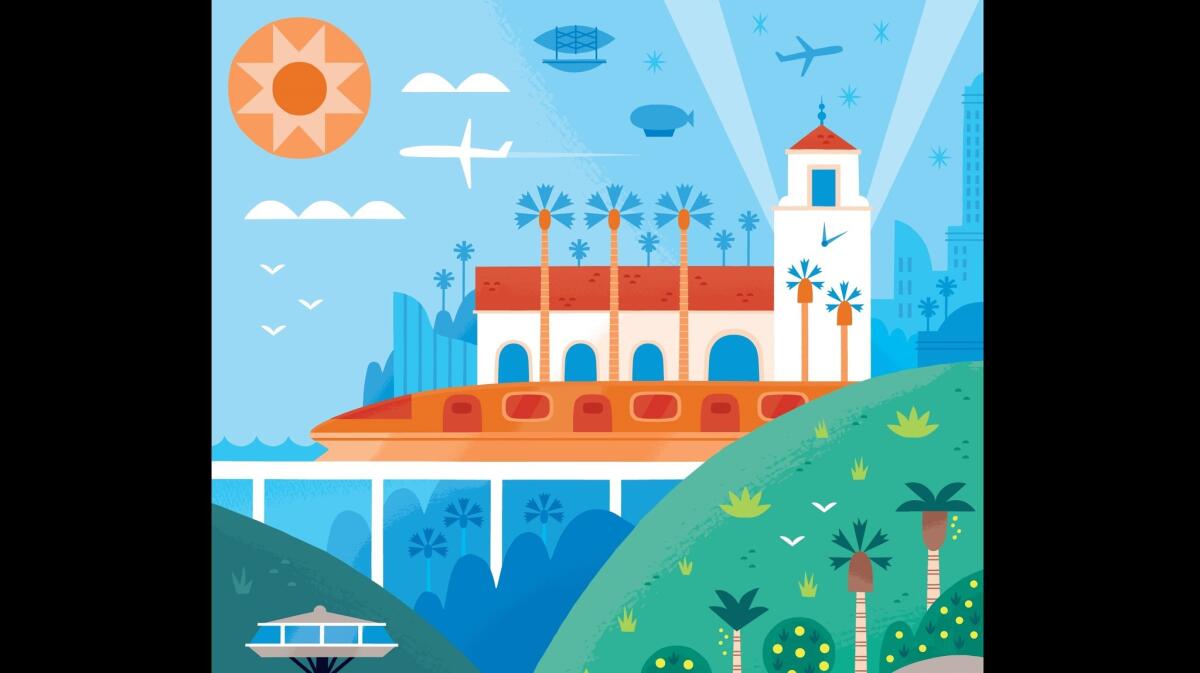Op-Ed: A letter from 2056: Utopian L.A. is where everyone wants to live

- Share via
Sorry, I’m not able to send this directly through SnapFace since your iPhone 6 doesn’t support neural chat. Old-fashioned text pixels will have to do. Remember the movie “Her”? That’s what Los Angeles is like in 2056. L.A. is the densest city in the U.S., with a population that’s about a third larger than it was in 2016. Taller buildings are everywhere, including New DTLA — a corridor of super-talls that runs the length of Wilshire all the way to Santa Monica.
Thanks to voters approving two big transit measures in 2016 (Measure R2) and 2030 (Measure RU4RL) we now have the most comprehensive rail system in the country. Take that, New York! All the subway and light-rail lines that were under construction in 2016 are complete. Not only is there a train to LAX, there’s one that goes under Sepulveda Pass, and another one through West Hollywood. There’s even high-speed rail at Union Station, which you can ride to Las Vegas and Tijuana.
The Bike Metro system that launched in 2016 reaches pretty much everywhere. Several streets are now open only to bikes, and the bike freeway on Figueroa — which used to be a very dangerous street for bikes, as you know — is the longest one in the country. We also have Metro e-bikes, which are great for canyon roads or for getting to the hilly parts of the L.A. Greenway, a gigantic continuous ring of hiking trails and bike paths around the city.
We still have cars, but auto ownership is now less than 10% because autonomous vehicles are cheap and plentiful. Everyone gets around using driverless UberLyfts or these cute autonomous minivans run by Google Transit. We call them Google Buses, which is funny, because I remember that meaning something totally different in 2016.
With fewer single-passenger vehicles on the road, our extra-wide freeways have been turned into housing and public space. Part of the 10 Freeway fell down in the Big One, but it was abandoned a long time ago because there are much better ways to get to the beach, like the Aqua Line (or what you call the Expo Line). The 101 and the 405 are now affordable-housing developments managed by Caltrans, which has nothing better to do.
Because so many people walk and bike, our quality of life is dramatically better.
Because so many people walk and bike, our quality of life is dramatically better. People walk their children to school and stay more active in the community, which means education has improved and crime is down. Pretty much everything I need in my HaFoSiLa neighborhood is a pleasant one-mile walk away — a pleasant tree-lined walk since the city planted 2 million trees to commemorate the end of Mayor Eric Garcetti’s third term.
You’ll be pleased to hear that the drought finally ended in 2019. But even before that, L.A. was able to get its residential water consumption down by half. A sidewalk bond allowed the city to replace its hardscape surfaces — not just sidewalks, but also parking lots — with more permeable materials, meaning what rain did fall could help refill naturally occurring aquifers. L.A. no longer needs to import water. The aqueduct was turned into a recreation zone that connects to the L.A. River in 2021 (the Cascades is now the coolest water slide). And yes, the L.A. River is swimmable, as are all the city’s lakes. MacArthur Lake is my favorite place to swim.
It’s summer, so you’re probably worried about blackouts. We got all that under control. With our transportation energy needs so greatly reduced, we weaned ourselves off fossil fuels in the ’40s. All of our power is supplied by something called distributed solar — super thin, modular solar skins designed by Elon Musk (still alive, thanks to vitamins) that can be stretched onto any building. These skins were made mandatory as part of a complete overhaul of the city’s zoning code, which helped L.A. develop vertically in time for the 2024 Olympics — which were great, by the way, once again the most fiscally responsible games in history.
Sorry, I’ve got to go. I’m supposed to have lunch in Palo Alto in an hour. But don’t worry, I won’t be too late: I can get from Santa Monica to San Jose in about 30 minutes. I know that seems crazy, but the Hyperloop is a thing of beauty. The Hyperloop also made it possible for Silicon Valley and Silicon Beach to merge, bringing economic prosperity to both regions and solving the housing crisis in San Francisco because most people realized they’d rather live in Los Angeles.
Alissa Walker is a Los Angeles-based writer and editor. Follow her on Twitter @awalkerinLA.
ALSO
A letter from 2056: Dystopian L.A. gives you everything you love to hate, only more of it
Follow the Opinion section on Twitter @latimesopinion or Facebook
More to Read
A cure for the common opinion
Get thought-provoking perspectives with our weekly newsletter.
You may occasionally receive promotional content from the Los Angeles Times.










